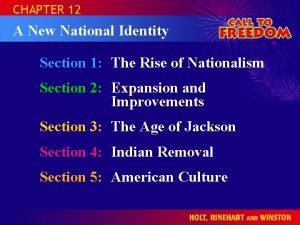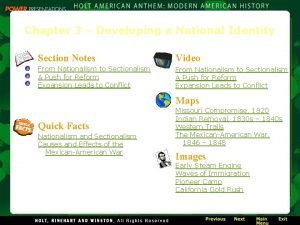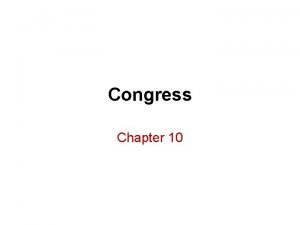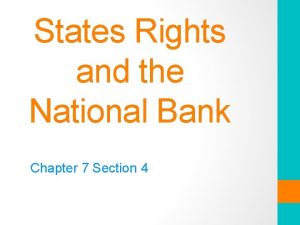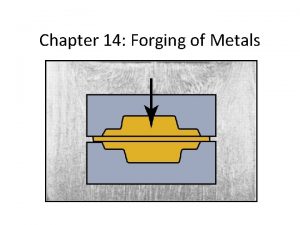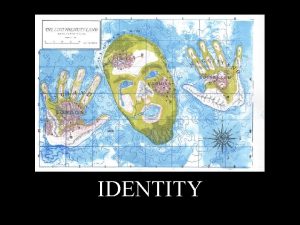Chapter 12 A New National Identity A New













- Slides: 13

Chapter 12 A New National Identity

A New National Identity • • • Section 1: The Rise of Nationalism Section 2: Expansion and Improvement Section 3: The Age of Jackson Section 4: Indian Removal Section 5: American Culture

Course Objectives

Section 1 The Rise of Nationalism

The Rise of Nationalism • I. The Era of Good Feeling (p. 364 -65) • A. Time of peace after the War of 1812 was known as the Era of Good Feelings. • B. Republican James Monroe won the presidential elections of 1816 and 1820. • C. Relations with British Canada • 1. Rush-Bagot Agreement of 1817 limited naval power on the Great Lakes for both the United States and British Canada.

The Rise of Nationalism • 2. Convention of 1818 gave the United States fishing rights off parts of the Newfoundland Labrador coasts. • 3. Also set border between Canada and United States at the 49 th parallel as far west as the Rocky Mountains • 4. In addition, both nations agreed to jointly occupy part of the Pacific Northwest

The Rise of Nationalism • II. The Issue of Florida (p. 365 -66) • A. Border with Spanish Florida • 1. Some Americans wanted to settle in Spanish Florida. • 2. Americans were also concerned about Seminole Indians in the region who aided runaway slaves and attacked U. S. towns.

The Rise of Nationalism • B. War • 1. President Monroe sent troops under Andrew Jackson to secure the border. • 2. Jackson’s troops invaded Florida to capture Seminole raiders, which began the First Seminole War. • 3. Also attacked Spanish posts and overthrew the governor of Spanish Florida, all without direct orders from President Monroe.

The Rise of Nationalism • C. The Treaty • 1. U. S. secretary of state John Quincy Adams and Spanish diplomat Luis de Onis negotiated the Adams-Onis Treaty of 1819 to resolve the conflict. • 2. Under the terms of the treaty, Spain gave East Florida to the United States and gave up its claims to West Florida.

The Rise of Nationalism • 3. In return, the United States gave up claims to Texas and agreed to pay up to $5 million of U. S. citizens’ claims against Spain.

The Rise of Nationalism • III. The Monroe Doctrine (p. 366 -67) • A. Spain’s Problems • 1. Spain’s Central and South American colonies challenged Spanish rule. • 2. Simon Bolivar, known as the Liberator, led many of these revolutions in Latin America, which gained the support of many people in the United States.

The Rise of Nationalism • B. A New Foreign Policy • 1. Monroe worried that other European might try to take control of the newly independent countries in Latin America. • 2. As a result, Monroe issued the Monroe Doctrine in 1823. • 3. Doctrine declared that foreign powers should not create new colonies in North and South America and that the United States would view European interference in Latin America as a hostile act. • 4. Some Europeans leaders protested but few challenged the act.

 A new national identity section 1
A new national identity section 1 A new national identity section 1
A new national identity section 1 Social identity mapping
Social identity mapping National identity
National identity Meiji restoration samurai
Meiji restoration samurai National unification and the national state
National unification and the national state Chapter 16 toward a new heaven and a new earth
Chapter 16 toward a new heaven and a new earth New zealand official languages english
New zealand official languages english Section 1 chapter 10 the national legislature
Section 1 chapter 10 the national legislature The national legislature chapter 10
The national legislature chapter 10 Chapter 7 section 4 states rights and the national bank
Chapter 7 section 4 states rights and the national bank Forging adalah
Forging adalah Split speech
Split speech New york, new jersey, pennsylvania, and delaware
New york, new jersey, pennsylvania, and delaware
